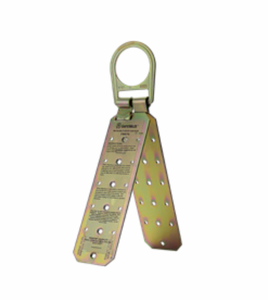 Whether you're a steel erector or a metal decking company, a butterfly roof anchor is a common choice for decking activities and accessing work areas, but there can be a catch. It’s critical to choose the right roof anchor because some are specifically designed for residential wood structures installed on the peak of the roof and NOT for steel erection or metal decking. After ANSI Z359.18-2017 was approved in August 2017, manufacturers’ product development teams started looking at the new rigorous anchor requirements. Even though the butterfly is an OSHA rated anchor, it is still a single user anchor, which is now deemed necessary for fastening through decking and purlin to ensure proper strength. Manufacturers updated their user manuals to reflect the changes but there was no memo to reflect the change from some manufacturers. Steel erectors and decking companies still had the old user manual stating screws did not have to penetrate a structural member underneath deck sheet. Before you get stuck with the wrong anchor, let's dive into the details. Know the Regulations OSHA's Subpart 1926.758(g) states that purlins and girts can't be used as anchorage points for fall arrest systems without written approval from a qualified person. So, before putting any system into use, make sure to submit a letter of override to ensure you're complying with safety standards and not compromising the structural integrity of the steel purlins.  Review Product Materials and Manuals The hinged roof anchors from major fall protection equipment manufacturers like Fall Tech, Safewaze, and 3M are often referred to as butterfly roof anchors and can be used on metal deck sheets in pre-engineered buildings with z-purlins. Falltech's Engineering Manager, Zack Winters, emphasizes that their model #7410 anchor can withstand a 5000 lb. load when fastened properly to a minimum 20-gauge steel deck. Just make sure to use the recommended fasteners and follow the installation instructions. Safewaze and 3M user manuals state a minimum 22-gauge metal roofing/decking over minimum 16-gauge Z-purlin. Fall Tech is the same with the exception of minimum 14-gauge Z-purlin instead of 16-gauge.  But what about different types of deck sheets? For floor deck sheets, which are usually 18-gauge, you’ll need to fill in the screw holes to prevent concrete leakage. And when it comes to commercial or industrial roof deck sheets, typically 22-gauge, the butterfly roof anchors won’t work on top of them alone. However, research shows that all three manufacturers allow screwing the butterfly anchor into a structural member underneath the deck sheet, such as a purlin. Other Considerations Installation manuals don’t provide information on anchoring butterflies to metal decking over steel bar joists or I-beams. You’ll need to assess the structure’s components, sheet gauge, purlin size, and availability to find the best anchor solution. And remember, an anchor system installed using columns or overhead can eliminate holes in deck sheets and purlins, providing greater fall distance clearances and less paperwork hassle with OSHA. So, next time you're choosing a roof anchor, keep these insights in mind. Safety first! References: DBI Sala, User Instruction Manual Hinged Roof Anchor Model Number: 2103676 Fall Tech, Metal Frame Structure Anchor 7410M User Instruction Manual Supplement Occupational Safety and Health Administration. (1970). Occupational safety and health standards: Occupational health and environmental control (Standard No. 1926 Subpart R) Safewaze, FS870 / FS870N / FS870S Reusable Roof Anchor Winters, Frost, July 31, 2019, #7410 Anchorage Connector in Metal Deck Applications, Fall Tech This Safety Flash was contributed by, Jeremy McAllister, Safety Director for Gardner-Watson, in cooperation with SEAA’s Safety & Education Committee. It’s designed to keep members informed about ongoing safety issues and to provide suggestions for reducing risk. Best practices are gathered from a variety of sources. They may be more or less stringent than individual corporate policies and are not intended to be an official recommendation from SEAA. Always get approval and direction from your company officers on any new practice or procedure as these best practices may not work for all situations.
Everyone benefits when a worker avoids injury. Submit your ideas for Safety Flash to [email protected]. Comments are closed.
|


 RSS Feed
RSS Feed
